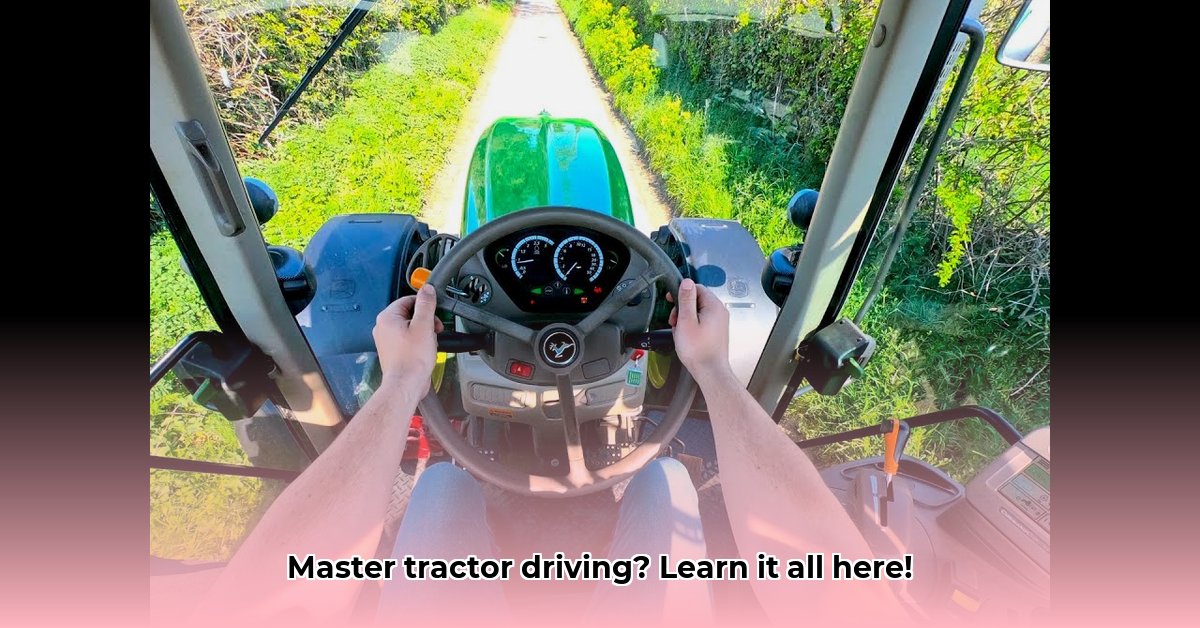
Driving a Tractor: A Complete Guide
Mastering tractor operation involves understanding the machine, prioritizing safety, and employing efficient techniques. This guide covers pre-operational checks, control mastery, safe driving practices, attachment management, maintenance, troubleshooting, and crucial safety considerations for both beginners and experienced operators. For more specific instructions on John Deere tractors, see this helpful guide: John Deere operation.
Pre-Operational Checks: Getting Ready to Roll
Before starting, a thorough pre-operational check is vital, similar to a pilot's pre-flight checklist. This isn't just about preventing breakdowns; it's about accident prevention.
Fluids Check: Verify engine oil, coolant, and fuel levels. Low levels can cause engine damage. Use the correct fluids specified in your owner's manual. Isn't it surprising how often a simple fluids check prevents major problems?
Tire Pressure: Proper inflation is crucial for traction, stability, and preventing blowouts. Use a gauge and consult your owner's manual for the recommended pressure. Incorrect tire pressure significantly impacts fuel efficiency and tire lifespan.
Visual Inspection: Carefully examine belts, hoses, and components for wear, cracks, or damage. Tighten any loose parts and replace damaged ones. Regular visual inspections can prevent catastrophic failures.
Stabilizer Check: Ensure stabilizer chains or mechanisms are securely fastened for enhanced stability, particularly when using implements. Stability is paramount, especially on uneven terrain.
Implement Check (If Applicable): Thoroughly inspect any attachments for wear, loose parts, or safety hazards. Verify correct attachment and secure fastening. A secure attachment is critical for preventing accidents and maximizing efficiency.
Mastering Tractor Controls and Transmission: Getting a Feel for the Machine
Understanding your tractor's controls and transmission is fundamental to safe and efficient operation. This is akin to learning to drive a car, but with significantly more power and potential hazards.
Transmissions: Tractors utilize either manual or automatic transmissions. Manual transmissions demand more skill, requiring precise clutch engagement and gear shifting. Automatic transmissions are generally easier but still require understanding of their operation and responses to different conditions.
Controls: Familiarize yourself with the location of all controls (throttle, brakes, lift levers, etc.) Your owner's manual is your best resource. Practice smooth clutch engagement and gear shifting to minimize wear and tear and maintain control. Smooth operation is key for extending the life of your tractor's components.
Safe Driving Practices: Navigating the Terrain
Safe driving encompasses more than collision avoidance; it’s about managing the tractor effectively and anticipating potential hazards.
Starting and Stopping: Always engage the parking brake when stopping and before dismounting. Remove the key to prevent accidental starts. This seemingly simple step prevents countless accidents.
Turning: Wide turns are safer, particularly on slopes or uneven ground. Tight turns can lead to instability and rollovers. Scan for obstacles before, during, and after turns. Adjust speed according to terrain and conditions. Slow and steady wins the race, especially when operating heavy machinery.
Visibility: Maintain clear visibility. Keep windows clean and be constantly aware of your surroundings. Operating with implements demands extra caution. Maintaining good visibility significantly reduces the risk of accidents.
Emergency Situations: Prepare for potential engine failure, tire blowouts, or other emergencies. Knowing how to respond calmly and efficiently is critical. Your owner's manual provides guidance, but practice and foresight are essential. Preparation is key to effective response during emergencies.
Attachment Management: Working with Implements Safely
Attaching and detaching implements safely is crucial, demanding precise adherence to your tractor's manual. Uneven weight distribution can severely compromise stability, leading to dangerous situations. Never exceed the tractor's rated capacity.
Preparation: Position the implement and tractor correctly for connection. Use chocks or supports to stabilize the implement.
Connection: Carefully align and secure the implement, using the correct pins, bolts, and locking mechanisms. Take your time and don't rush. Rushing can lead to improper attachment and potentially hazardous situations.
Double Check: After connecting, double-check all connections to ensure everything is firmly secured before engaging hydraulics or operating the implement.
Weight Distribution: Distribute the implement's weight evenly for stability. Some implements may require additional counterweights. Always consult your owner's manual.
Testing: After attachment, carefully test the implement before commencing any work.
Basic Tractor Maintenance: Keeping Your Tractor in Top Shape
Regular maintenance is vital for both performance and safety. A well-maintained tractor is a safer tractor.
Oil and Filters: Change oil and filters according to the owner's manual recommendations. Dirty oil and clogged filters reduce performance and engine lifespan. Regular oil changes are inexpensive insurance against costly repairs.
Tire Pressure: Maintain proper tire pressure for safety and fuel efficiency.
Cleaning: Clean the tractor after each use to prevent damage and safety hazards.
Regular Inspections: Perform regular visual inspections to identify and address potential issues promptly.
Troubleshooting Common Issues: Addressing Problems on the Spot
Even well-maintained tractors can encounter problems. Familiarity with common issues and their solutions is essential.
| Problem | Possible Cause | Solution |
|---|---|---|
| Engine won't start | Dead battery, fuel issues | Check battery, fuel lines, and starter |
| Unusual noises | Loose parts, worn components | Inspect components, tighten loose parts |
| Leaking fluids | Damaged hoses, seals | Inspect and repair or replace as needed |
| Difficulty steering | Low hydraulic fluid, worn parts | Check hydraulic fluid, inspect steering system |
Safety First: A Final Note
Always prioritize safety. Wear appropriate safety gear (sturdy footwear, gloves, eye protection). Never operate a tractor when fatigued or under the influence of substances. Careful preparation and adherence to safe practices contribute significantly to safer operation and extend your tractor's lifespan. Remember, safety isn't just a suggestion; it's a necessity!
Key Takeaways:
- Pre-operational checks are crucial for preventing accidents and ensuring efficient operation.
- Mastering tractor controls and understanding the transmission (manual or automatic) are paramount for safe operation.
- Safe driving practices, including smooth maneuvers and hazard awareness, are essential for accident prevention.
- Proper attachment management ensures both safety and effective operation of implements.
- Regular maintenance prevents major breakdowns and extends the life of your tractor.
- Troubleshooting common problems minimizes downtime and allows for swift resolution.